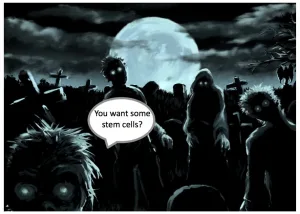At the outset, let me add a brief preface. Part 1 of this look at the Vatican series of conferences on cell research and the biotech industry began on this weblog last month. I had promised a Part 2. Much of that promise appeared in The Federalist, July 15th, under the title “Inside The Vatican’s Surprising Alliance With Biotech Venture Capital.” For clarity’s sake—and to avoid repetition here—it makes sense to read The Federalist piece first.
Part 2 introduced the mystic marriage of Cardinal Ravasi and the entrepreneurial Robin L. Smith, MD, a mergers-and-acquisitions specialist and stakeholder on the boards of multiple biotech firms. Nuptials were consummated in the First International Vatican Conference in 2011. The fifth “healthcare initiative,” held this year in early May, marks the couple’s tenth anniversary. What follows below adds detail to the celebration.

These Vatican happenings mimic the annual J.P. Morgan Healthcare Conference. Begun thirty nine years ago, it is the largest and most comprehensive symposium in the industry. Every year everyone who is anybody in biotech/biopharma—or wants to be—converges on San Francisco at the J.P. Morgan conference to check the oxygen level of the financial markets. Industry leaders, technology innovators, and members of the investment community talk programs, ideas, and aspirations with deal-makers and entrepreneurs. Representatives of emerging companies, like those promoted by Smith, explore financial trends, scientific protocols, and public health initiatives alongside established ones, e.g. California’s Amgen
The Pontifical Council’s rendition of J.P. Morgan’s event tilts into burlesque. From Cardinal Ravasi’s conceptual orchestra pit come entr’actes to lighten audience mood between headline numbers. My favorite is rocker Joe Perry’s counsel: “You have to go where you are not afraid to go outside of the box—where you can feel free, cut loose and not worry about the consequences.” Perry followed his own advice, shooting Aerosmith cash into his veins. His presence here is as bizarre as it is poignant.
[He reminded the camera his new album is coming out this year. Our hipster cardinal timed Perry’s Vatican gig perfectly. Ravasi deserves a kickback on ticket sales for Aerosmith’s June-September tour.]

Vatican rationale for its own conference series was desire to encourage adult stem cell research. But there was never a whisper about reasons for its intention. Pumping a small, select segment of the industry is not an argument. Had this been a real conference, not a disguised commercial, it would have examined ongoing embryonic stem cell research that relies not on abortions but on surplus embryos generated through “assisted reproductive technologies.”
The Catechism opposes in vitro fertilization. Yet the conference chose not to take strategic advantage of already existing contention within the industry on use of surplus embryos. Why not? Pope Francis promotes vaccines made from cell lines derived from aborted fetuses. Might that weigh against Church teaching on cell lines cultured from redundant embryos slated for disposal? The Vatican bazaar kept mum.
• • • • •
A serviceable overview of socio-ethical dimensions of embryo donation is here.
• • • • •
In 2007 a team of scientists at UCLA’s stem cell research center, created the first human induced pluripotent stem cells (iPSC). These are derived from adult skin or blood cells that have been re-engineered back into an embryonic-like pluripotent state that enables the development of any type of human cell needed for therapeutic purposes. A stunning technological feat, it has been generating excitement in the industry on its own.
The field has swollen into a welter of competing players, many of them unreliable. Molecular biologist Paul Knoepfler writes:
How can you tell who to trust in the world of stem cell therapy? What information can a patient trust? Once upon a time, about a dozen years ago, it seemed a much simpler question.
There were universities and biotech companies doing legit research as well as clinical trials, and there were physicians doing bone marrow transplant type work. Back then on the other side there were just a handful of stem cell clinics, mostly outside the U.S., selling sketchy stuff.
Now in 2021 things are a mess.
Compounding the mess is stem cell tourism and mushrooming stem cell clinic-associated businesses in the ecosystem:
These include suppliers who target care providers as customers. The suppliers sell mostly ‘dead’ cellular extracts often made from birth-related tissues like umbilical cord, placenta or amnion. Yet these products are generally sold in such a way as to give the impression they are both living cells and specifically stem cells.
Knoepfler adds: “Another important element of stem cell clinic industry are promoters that mostly didn’t exist some years back.”

Discount Vatican incentives for its series of biotech promotions. What remains is the spectacle of the Church making itself inconsequential. Ecclesiastical historian Edward Norman recognized the drift to irrelevance some forty-five years ago:
Christianity is not being rejected in modern society—what is causing the decline of public support for the Church is the insistence of church leaders themselves in representing secular enthusiasm for humanity as core Christianity.
Those enthusiasms, however humane, participate in modernity’s eclipse of the holy. Christianity, like Judaism, prompts us to meet the demands of God. These 3-day Vatican conferences pivot on the demands of man. The ancient Hellenic cult of health and beauty returns in the guise of what Robin Smith calls “the impact of wellness through prevention.”
Also in return engagement is the ancient quest, dating back to Herodotus, for the fountain of youth. David Sinclair, a professor of genetics and co-director of Harvard’s Center for Biology of Aging Research, contributes this:
We can reverse aging! . . . Eventually, we think we could have treatments—an injection or a pill—that could reset the body by a decade or more. And we could keep doing and redoing that reset, time and time again.
Ponce de Leon recidivus! Cardinal Ravasi presumes familiarity with American culture and letters. Yet he seems to have missed Dr. Heideggar’s Experiment, Nathaniel Hawthorne’s warning against the folly of the search for eternal youth.
• • • • •
Health is a great good. No one needs the Vatican to tell us. Neither do we need the CEO of the Regenerative Medicine Foundation to chirp: “There is an incredible enthusiasm for longevity.” Or another to boast that the first person who will live to be 150 “has already been born.” Our own ache to forestall finitude by curing disease is sufficient for pursuing regenerative medicine. Vatican boosterism is superfluous.
The Church is needed to quicken in us a taste for God. It exists to remind us that mortal transience is our route to transcendence. But this Vatican prefers fashionable detours. Pop spirituality, much of it the stuff of self-help and mindfulness books, is an easier sell.
To wit: Meditation releases your infinite potential. Music changes the balance between opposing sides of your nervous system. Food is “the most powerful drug on the planet.” Your gastrointestinal biome is your best friend. Cindy Crawford, with a net worth of some $400 million, shares healthy living secrets for stress-free living. A physical therapist with the CDC instructs us “to be patient with ourselves” and get “plenty of sleep.” Director of Sanford Institute of Empathy and Compassion informs us that empathy and compassion enhance “wellness.” A healthcare activist warns that the toxic effect of loneliness is “equivalent to smoking 15 cigarettes a day.”
But it is not all candy. Jane Goodall arrives to scold us for destroying the planet. And to announce that chimpanzees have something to tell us about what it means to be human.
• • • • •
An aside: Albert Bourla, Pfizer’s Chairman and CEO, is a veterinarian. He earned a Ph.D. from the Veterinary School of Aristotle University, Thessaloniki, and began his career at Pfizer in the Animal Health Division in 1993.
• • • • •
What is man? That is the question the Church is ordained to answer. We are each, in Jean Mouroux‘s wording “a frail cluster of cells heading straight for dispersion.” No matter how long we live, in Christian eyes we remain wayfarers stumbling toward Him in whose image we are made.
Do we gain better understanding of a Christian life via the network designs of MBAs in healthcare management? The global biotechnology community has an answer. Of sorts. Listen to John Crowley, CEO of Amicus Therapeutics: “When it comes to rare diseases we are in a race against the clock; we are also in a race against the mistakes of nature.”
Mistakes of nature. What—and who—are they? The phrase lends itself to far-reaching application. It brings me again to Mouroux. Only if man is recognized as a being created in God’s image, is there hope for modernity. So seen, man is an object of reverence no matter an individual’s condition of deformity or degradation:
Why be surprised at [the body’s] limitations and miseries? They are normal enough in a creature that bears its own nothingness about with it, in an animal creature whose life is simply a promise of death. They should help to keep us clear of absurd worship of the body . . . . They should dispose us to the adoration of Him who alone who is without limitations and miseries, who knows of what clay we are made, how brief our days, how humble our paths.
The body is not an end in itself, not an idol. It is “an instrument,” one “penetrable by the spirit and fit to do it service.” The Church fulfills its commission by declaring a singular truth: Instruments out of tune, we were purchased at a price.
Seen in light of this conference, the Vatican is out of sympathy with the Church.



